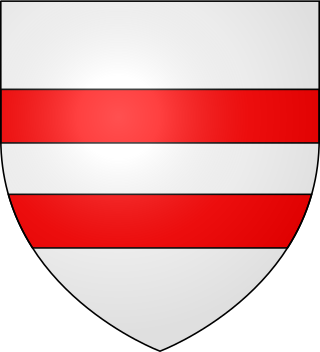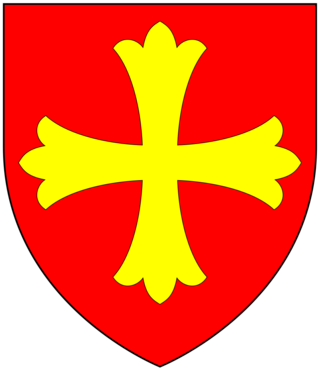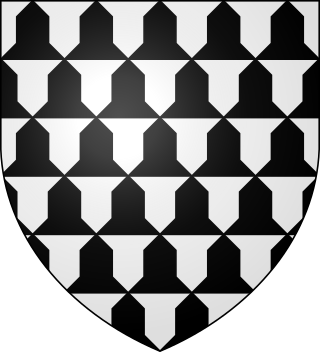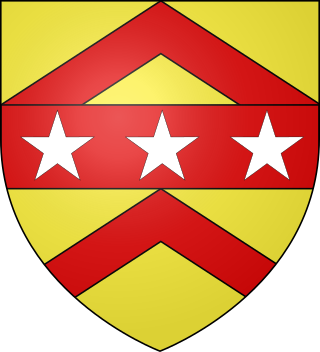
Almaric de St. Amand (born 1268 or 1269; died 1310), also known as Amauri de St Amand, Lord of Widehaye was an English noble. He fought in the wars in Gascony and Scotland. He was a signatory of the Baron's Letter to Pope Boniface VIII in 1301. [1]

Almaric de St. Amand (born 1268 or 1269; died 1310), also known as Amauri de St Amand, Lord of Widehaye was an English noble. He fought in the wars in Gascony and Scotland. He was a signatory of the Baron's Letter to Pope Boniface VIII in 1301. [1]
Almaric, born in 1268 or 1269, was the second son of Almaric de St. Amand. He succeeded his elder brother after Guy died not long after their father. Almaric served in Gascony in 1294, and in Scotland during 1300 and 1306. The title Baron St Amand was created for him in 1299 but became extinct when he died without issue. He was at the Siege of Carlaverock Castle in 1300 when his arms were recorded in verse in the Caerlaverock Roll as follows:
He was summoned to Parliament in 1300 and signed the Barons' Letter to the pope, on 12 February 1301. He died in 1310, without issue and was succeeded by his brother John.

FitzMartin or Fitz Martin was the surname of a Norman family based in England and Wales between 1085 and 1342.

Henry de Hastings of Ashill, Norfolk, was a supporter of Simon de Montfort in his rebellion against King Henry III. He led the Londoners at the Battle of Lewes in 1264, where he was taken prisoner, and fought at the Battle of Evesham in 1265, where de Montfort was killed. He resisted King Henry III's extensive siege of Kenilworth and after the Dictum of Kenilworth he commanded the last remnants of the baronial party when they made their last stand in the Isle of Ely, but submitted to the king in July 1267. In 1264 he was created a supposed baron by de Montfort, which title had no legal validity following the suppression of the revolt.

Robert FitzWalter, 1st Baron FitzWalter was an English landowner, soldier, administrator and politician.
John Hastings, 1st Baron Hastings, was an English landowner, soldier and administrator who was one of the Competitors for the Crown of Scotland in 1290 and signed and sealed the Barons' Letter of 1301. He was Lord of the Manor of Hunningham.

John Segrave, 2nd Baron Segrave was an English commander in the First War of Scottish Independence.

John (V) de Mohun, 2nd Baron Mohun, 9th feudal baron of Dunster, KG (1320–1376) was a founder member and the 11th Knight of the Most Noble Order of the Garter in 1348.

Simon de Montagu, 1st Baron Montagu was summoned to Parliament by writ and thereby became the 1st Baron Montagu. He was the ancestor of the great Montagu family, Earls of Salisbury.

Robert fitzRoger (1247–1310), Lord of Warkworth, Clavering and Eure, was an English baron. He was a son of Roger FitzJohn and Isabel de Dunbar. FitzRoger fought in the wars in Wales, Gascony and Scotland.

John de Moels, 1st Baron Moels, feudal baron of North Cadbury in Somerset, was an English peer.

Fulk le Strange, 1st Baron Strange of Blackmere was an English noble. He fought in the wars in Gascony and Scotland. He was a signatory of the Baron's Letter to Pope Boniface VIII in 1301.

William de Cantilupe, 1st Baron Cantilupe (1262-1308) of Greasley Castle in Nottinghamshire and of Ravensthorpe Castle in the parish of Boltby, North Yorkshire, was created Baron Cantilupe in 1299 by King Edward I. He was one of the magnates who signed and sealed the Barons' Letter of 1301 to the pope and was present at the Siege of Caerlaverock Castle in Scotland in 1300, when his armorials were blazoned in Norman-French verse in the Caerlaverock Roll.

John FitzReginald, also known as John FitzReynold, Lord of Blenlevenny was an English noble. He was a signatory of the Barons' Letter of 1301.

Baron St Amand was a title created twice in the Peerage of England: firstly in 1299 for Amauri de St Amand, who died without issue, when it became extinct; and secondly in 1313 for his brother John de St Amand (1283/6–1330).

William le Latimer, Lord of Corby and Billinges was an English noble. He was a crusader and served in English campaigns in Wales, Gascony, France and Scotland.
Peter Corbett, 2nd Baron Corbet, Lord of Caus was an English noble. He fought in the wars in Scotland. He was a signatory of the Baron's Letter to Pope Boniface VIII in 1301.

Herny de Teyes, 1st Baron Teyes , Lord of Chilton was an English noble. He fought in the wars in Wales, Flanders and Scotland. He was a signatory of the Baron's Letter to Pope Boniface VIII in 1301.

Robert de La Warde, 1st Baron De La Ward, Lord of Alba Aula, Burton Overy and Upton, and Newhall was an English noble. He fought in the wars in Gascony, Flanders and Scotland. He was a signatory of the Baron's Letter to Pope Boniface VIII in 1301.

Walter de Teye, Lord of Middleton and Stonegrave was an English noble. He fought in the wars in Scotland. He was a signatory of the Baron's Letter to Pope Boniface VIII in 1301.

Adam de Welles, 1st Baron Welles, Lord of Welles, was an English noble. He fought in the wars in Flanders and Scotland. He was a signatory of the Baron's Letter to Pope Boniface VIII in 1301.

William Paynel, 1st Baron Paynel, Lord of Trotton, Littleton, Knighton Paynel and Woolbedding, was an English noble. He fought in the wars in Flanders and Scotland. He was a signatory of the Baron's Letter to Pope Boniface VIII in 1301.